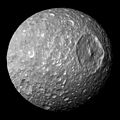Súbor:Mimas Cassini.jpg

Veľkosť tohto náhľadu: 600 × 600 pixelov. Iné rozlíšenia: 240 × 240 pixelov | 480 × 480 pixelov | 768 × 768 pixelov | 1 024 × 1 024 pixelov | 1 800 × 1 800 pixelov .
Pôvodný súbor (1 800 × 1 800 pixelov, veľkosť súboru: 943 KB, MIME typ: image/jpeg)
História súboru
Po kliknutí na dátum/čas uvidíte ako súbor vyzeral vtedy.
| Dátum/Čas | Náhľad | Rozmery | Používateľ | Komentár | |
|---|---|---|---|---|---|
| aktuálna | 18:51, 23. január 2011 |  | 1 800 × 1 800 (943 KB) | WolfmanSF | {{Information |Description ={{en|1=In this view captured by NASA's Cassini spacecraft on its closest-ever flyby of Saturn's moon Mimas, large Herschel Crater dominates Mimas, making the moon look like the Death Star in the movie "Star Wars." Herschel C |
| 02:36, 19. máj 2010 |  | 2 000 × 2 000 (864 KB) | The High Fin Sperm Whale | {{Information |Description={{en|1=In this view captured by NASA's Cassini spacecraft on its closest-ever flyby of Saturn's moon Mimas, large Herschel Crater dominates Mimas, making the moon look like the Death Star in the movie "Star Wars." Herschel Crat |
Použitie súboru
Na tento súbor odkazujú nasledujúce 3 stránky:
Globálne využitie súborov
Nasledovné ďalšie wiki používajú tento súbor:
- Použitie na af.wikipedia.org
- Použitie na am.wikipedia.org
- Použitie na ar.wikipedia.org
- Použitie na ary.wikipedia.org
- Použitie na arz.wikipedia.org
- Použitie na ast.wikipedia.org
- Použitie na azb.wikipedia.org
- Použitie na az.wikipedia.org
- Použitie na ba.wikipedia.org
- Použitie na be-tarask.wikipedia.org
- Použitie na be.wikipedia.org
- Použitie na bg.wikipedia.org
- Použitie na bn.wikipedia.org
- Použitie na bn.wikibooks.org
- Použitie na br.wikipedia.org
- Použitie na bs.wikipedia.org
- Použitie na ca.wikipedia.org
- Použitie na ckb.wikipedia.org
- Použitie na crh.wikipedia.org
- Použitie na cs.wikipedia.org
- Použitie na cv.wikipedia.org
- Použitie na cy.wikipedia.org
- Použitie na da.wikipedia.org
Zobraziť ďalšie globálne použitie tohto súboru.





